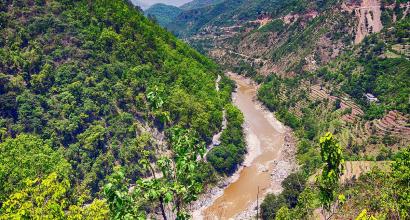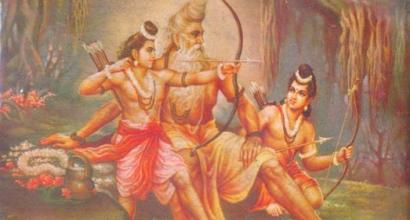Yudhiṣṭhira made his way into the enemy ranks and walked straight to Bhīṣma. He bowed down to the grandsire, touched his feet, and said with great humility, “Grandfather, I am going to fight against you in this war; please give me permission. I seek your blessings.”
Bhīṣma replied, “If you had not come here now, you would have been cursed by me and would have lost this war. I’m overjoyed that you came; I grant you permission to fight me; may you be victorious! Ask me for any boon, except stopping this war; I will grant it to you. It is true that man is a slave of wealth but wealth is not a slave to anyone. It is because of receiving the wealth of the Kauravas that I’m trapped in this dilemma today. Therefore, utterly helpless, I have to add the caveat ‘except stopping the war.’ I’m obliged to fight on the side of the Kauravas but I wholeheartedly wish that you emerge victorious!”
Then, in a similar manner Dharmarāja bowed down to Droṇa, seeking his permission and blessings.
Droṇa said, “You have my permission to wage this war; you have Śrīkṛṣṇa as your minister, so your victory is assured.”
Dharmarāja asked, “Ācārya, how to defeat you in battle?”
Droṇa replied, “As long as I am fighting on the battlefield, victory will evade you. Therefore, you and your brothers should try and kill me at the first opportunity!”
Yudhiṣṭhira asked, “If that is the case, kindly tell me how we can kill you. I ask you this with folded hands.”
“I don’t see anyone who can kill me in combat so long as I’m on the battlefield. One can only kill me when I abandon my weapons and sit still. And if I have to let go of my weapons on the war-field, it must only be because someone whom I trust gives me extremely unpleasant news.”
After this, in a similar manner, Yudhiṣṭhira approached Kṛpa and Śalya, paid obeisance to them and sought their blessings to begin the war. Śalya said that just as he had promised earlier, he would diminish the enthusiasm and vigour of Karṇa by his piercing words at the opportune time. When the Pāṇḍavas turned back and returned to their armies, Kṛṣṇa approached Karṇa and said, “I’ve heard that you have refused to share the battlefield with Bhīṣma because you’re angry with him. In that case, until Bhīṣma is killed in battle, come over to our side! After Bhīṣma dies, you may rejoin your side and fight for Duryodhana, helping him out.
In response Karṇa said, “Keśava! I will not do anything that causes displeasure to the Kaurava [i.e., Duryodhana]. I am his well-wisher and I’m ready to sacrifice my life for his sake!”
Then Yudhiṣṭhira shouted out, “If any of you wish to leave the Kaurava forces and join us, he is most welcome!” At that point, Yuyutsu [Duryodhana’s step brother] stepped aside, expressed his wish, and joined the Pāṇḍava army. All the Pāṇḍavas returned to their designated spots in the army. Dharmarāja donned his armour. Everyone sat down in their chariots. The battle formation was as before. “Oh what respect the Pāṇḍavas have for elders! What compassion they have towards the wise!” said the kings among themselves. Soon after, indicating the commencement of war, conches were blown and drums and tabors were struck, making a lot of noise.
First, Duśśāsana kept Bhīṣma in front of him and launched an attack on the Pāṇḍavas. The Pāṇḍavas repulsed him by keeping Bhīma in front. A ghastly war began. Without care for father-son, relatives, and friends, the warriors started striking the enemy forces. That afternoon, Uttara-kumāra fought with Śalya and was killed in the process. The bow of Bhīṣma, who was resplendent like the raging sun at noon, was constantly bent as he let out shaft after shaft without ever stopping in the battle. The Pāṇḍava army was hit and became scattered. Uproars and cries were heard. By this time, the sun had set and it became quite dark so the first day’s battle came to an end.
The next morning, Dhṛṣṭadyumna arranged the Pāṇḍava army in the Krauñca-vyūha (battle formation resembling a heron) and made Arjuna stand right in the front, leading the battalion. Arjuna waged war against Bhīṣma and Dhṛṣṭadyumna attacked Droṇa. Bhīma killed the kings of Kaḻiṅga and other provinces. The second day of war came to an end.
On the third morning, Bhīṣma arranged the Kaurava army in the Garuḍa-vyūha (battle formation resembling Garuḍa, the mythical bird) and stood in the place of its beak-tip. In response, the Pāṇḍavas arranged their army in the crescent-moon formation. At first, Arjuna strongly attacked the Kaurava army. At that point, Duryodhana came to Bhīṣma and complained that he was being partial to the Pāṇḍavas and also that he, Droṇa, and others were not fighting to their full capacity, aligned to their valour. Enraged, Bhīṣma said, “I’ve said this several times earlier: the Pāṇḍavas are simply invincible. Those are well-meaning words. True words. I’m an old man; to the extent that is possible for me, won’t I fight? I will.” Saying these words, he stood firm of heart and made the Pāṇḍava army run helter-skelter. Arjuna, who was facing him in single combat, wasn’t able to move his hands properly. Constantly letting out arrows from his bow, Bhīṣma was slaying the determined soldiers of the Pāṇḍava army by the thousands. Kṛṣṇa, who saw this, thought to himself: “Although Bhīṣma has unleashed a terrifying assault on our army, this Arjuna, having forgotten his duty, is dealing with him softly, out of respect for the grandsire. The Pāṇḍava army is depleting fast; if this continues, Bhīṣma will single-handedly reduce the strength of the Pāṇḍavas in a short time. Therefore I shall kill Bhīṣma myself and reduce the burden on the Pāṇḍavas.” He took his Cakra in hand and rushed towards Bhīṣma on foot.
Looking at that, Bhīṣma said, “Come Kṛṣṇa! If you were to attack me, what can be a greater honour? If I die at your hands I will obtain both here and hereafter!”
Arjuna jumped out of his chariot, ran to Kṛṣṇa, held him by his shoulders, and tried to stop him. But Kṛṣṇa dragged Arjuna along with him and moved forward, just as a powerful cyclone pulls great trees along with it and rushes forward. Therefore Arjuna held on to Kṛṣṇa’s legs. Even then he did not stop until he had taken ten steps forward. Finally, with great difficulty, getting Kṛṣṇa to stop, Arjuna said these words in a beseeching tone: “Give up this anger of yours, Krishna! If you forsake us, what will be the fate of the Pāṇḍavas? I swear by my brothers and by my children, I will not swerve from my duty, I will not lag in fulfilling by responsibility. I will destroy the Kauravas!”
Satisfied by Arjuna’s oath, Krishna returned to the chariot, Cakra in hand, and then blew his Pāñcajanya conch with tremendous force. Soon, Arjuna filled the quarters with thousands of arrows. That day’s battle belonged to Arjuna. Unable to face the strike of his Aindrāstra, warriors like Bhīṣma, Droṇa, Duryodhana, and Bahlika retreated. By this time, dusk had engulfed the battlefield and the third day’s war came to an end.
To be continued…
This is an English translation of Prof. A R Krishna Shastri’s Kannada classic Vacanabhārata by Arjun Bharadwaj and Hari Ravikumar published in a serialized form.
The original Kannada version of Vacanabhārata is available for free online reading here. To read other works of Prof. Krishna Shastri, click here.












































